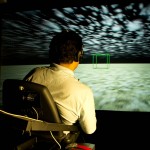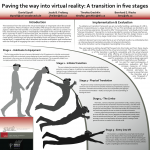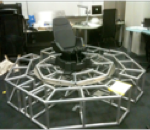Timofey Grechkin
Biography
Timofey joined iSpace Lab from 2012 — 2014 after receiving his PhD in Computer Science from the University of Iowa.
Projects
How do we best design locomotion interfaces for VR that provide "enough" physical motion cues (vestibular/proprioceptive) while still being effective, affordable, compact, and safe?
Despite amazing progress in computer graphics and VR displays, most affordable and room-sized VR locomotion interfaces provide only little physical motion cues (e.g., vestibular & proprioceptive cues). To provide...
How can we ease users' transition from the real surroundings into the virtual world?
Many of today’s virtual reality (VR) setups are very much focused on technical aspects rather then the benefits of a coherent user experience. This work explores the idea of enhancing the VR experience with a transition phase. On a physical level, this transition offers the user a meaningful metaphor for en...
Collaboration between the iSpace lab at SIAT and Mechatronics Undergraduate Interns to design and build a unique, virtual reality multi-modal motion simulator
The iSpace program is centered on investigating what constitutes effective, robust, and intuitive human spatial orientation and behaviour. This fundamental knowledge will be applied to design novel, more effective human-computer interfaces ...
Publications
http://ispace.iat.sfu.ca/wp-content/plugins/zotpress/
37904
Sproll, D., Freiberg, J., Grechkin, T., & Riecke, B. E. (2013). Paving the way into virtual reality - a transition in five stages. IEEE Symposium on 3D User Interfaces, 175–176. https://doi.org/10.1109/3DUI.2013.6550235
37904
Freiberg, Jacob, Timofey Grechkin, and Bernhard E. Riecke. 2013. “Do Walking Motions Enhance Visually Induced Self-Motion Illusions in Virtual Reality?” In IEEE Virtual Reality, 101–2. Lake Buena Vista, FL, USA: IEEE. https://doi.org/10.1109/VR.2013.6549382.
37904
Riecke, Bernhard E., Jacob Freiberg, and Timofey Y. Grechkin. 2015. “Can Walking Motions Improve Visually Induced Rotational Self-Motion Illusions in Virtual Reality?” Journal of Vision 15 (2): 1–15. https://doi.org/10.1167/15.2.3.
37904
Kitson, Alexandra, Timofey Y. Grechkin, Markus von der Heyde, and Bernhard E. Riecke. 2017. “Navigating Virtual Environments – Do Physical Rotations Aid in Orientation?” Poster presented at the Second International Workshop on Models and Representations in Spatial Cognition, Tübingen, Germany, April 6.
37904
Kitson, Alexandra, Timofey Y. Grechkin, M. von der Heyde, and Bernhard E Riecke. 2016. “Effect of Physical Rotations and Gender for Navigation Performance in Virtual Environments.” Poster presented at the International Meeting of the Psychonomic Society, Granada, Spain, May.
http://www.ps2016.org/.
37904
Grechkin, Timofey Y., and Bernhard E Riecke. 2014. “Re-Evaluating Benefits of Body-Based Rotational Cues for Maintaining Orientation in Virtual Environments: Men Benefit from Real Rotations, Women Don’t.” In ACM Symposium on Applied Perception SAP, 99–102. Vancouver, Canada: ACM. https://doi.org/10.1145/2628257.2628275.



